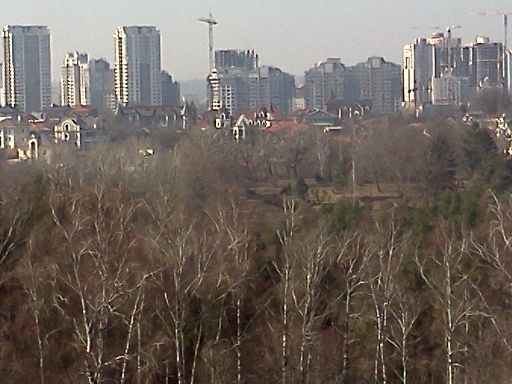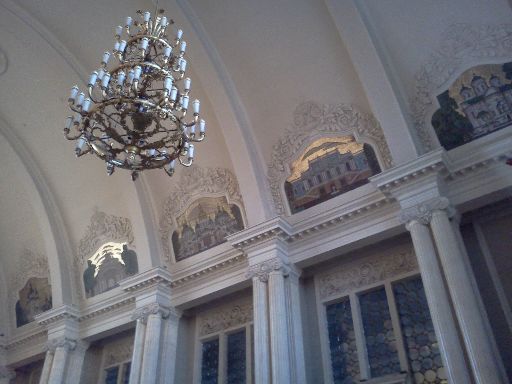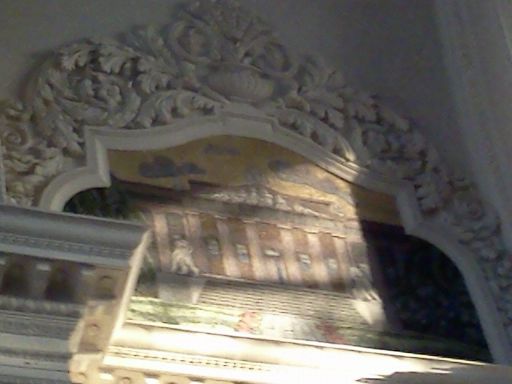Kyiv 2014
My trip to a post-revolutionary Ukraine
March 10 (Monday in the gardens and on the streets)
Since the trip to Lviv was canceled, I had a couple of extra days in Kyiv, and after lattes with Mila at a nearby café and a quick mini-bus ride, much of Monday was spent walking around the sizable Gryshko National Botanical Garden. The first signs of a coming spring were just barely present, and we saw singing birds and bright yellow butterflies pass by. A millennium-old but still active monastery, Vydubychi Monastery, was surrounded by the park. We also passed by greenhouses with tropical birds and plants, and had a good view of the city, including the many, many high-rises already up and still going up. Mila remarked on the number of children at the park. It was deceptive; Ukraine's population crisis was not evident at all there, but of course on a beautiful day in a city of millions with most living in apartments, you were going to see families out at the park. Also there was the mistletoe that seemed to be the primary form of greenery this time of year, and Eastern European (red) squirrels, which, unlike their American (gray) brethren, have tufts of fur pointing up on their ears.
 |
We also stumbled across a Korean-style "traditional garden," in the style of Seoul's Changdeokgung Palace, which I had skipped seeing when visiting Seoul, in favor of Gyeongbokgung Palace. This was a 2012 gift from South Korea on the occasion of the 20th anniversary of diplomatic relations between South Korea and a then-newly-independent Ukraine.
Just before leaving, we walked up some steps to what seemed to be the highest point in the park, or at least the part of the park near the exit. Then, after a bit of a walk to the nearest Metro station — we had taken the mini-bus there — we went back to Z.B. for lunch. For my last time there, I had pretty much the same things as I had the first time.
I then wandered around the Maidan once again. There were, again, the vendors selling Euromaidan souvenirs — slightly more expensive than their non-Maidan counterparts — and folks who seemed to be giving talks about the defenses, either applied to the protests, earlier conflicts, or just in general. This time there appeared to be a religious leader on stage, and he appeared to be administering a pledge or prayer or some sort. The audience was rapt, and one bemused observer remarked, to me, in Russian-accented English, that the crowd must be under hypnosis. I'm going to guess that she wasn't a supporter of the movement.
From there I walked to a place where, until recently, a statue of Lenin stood. It was pulled down during the protests, though opinion polls indicated that this action did not have widespread support. Still, as symbolism, the empty pedestal worked. Someone was event recording video in the style of a reporter, recalling how the protesters had said that Yanukovych would be next. Below the pedestal, a graffiti artist wrote, "Glory to Ukraine."
From there I walked through parks on either side of Taras Shevchenko University, the place the Universytet Metro station is named after. I also walked by the National University of Food Technologies, an oddly specific university that was suspiciously close to both a vegetarian restaurant and a delivery motorcycle for Varenicnaya Katysha. But, having already eaten, I settled for just a tiramisu-flavored ice cream novelty. Again, my knowledge of Cyrillic helped here, since, in Cyrillic cursive lettering, "Tiramisu" looks like "Mipamicy."
I then headed to the more utilitarian side of Kyiv, where the main "attractions," so to speak, were a new stadium, a century-old Gothic Revival Catholic Church, and the main train station, with a beautiful interior including mosaics applicable to Kyiv. Ironically, it was near the church that I was handed a card advertising a Purim festival. I suspected that this was just an excuse to party, as Kyiv has relatively few Jews as a percentage of the overall population. (In fact, upon later running the text through Google Translate, I found it to read, "You might not be Jewish, but you can still celebrate Purim.")
 |
 |
Now, for much of my time in Kyiv, especially my last few days, one thought had returned to my mind again and again: When I run out of things to do, I could try to go to Mezhyhirya. Mezhyhirya is the private estate of the former President, lavishly appointed and acquired from the public via dubious means. When he fled, Ukrainians lined up to have a peak at the lifestyle being lived at their expense, and news reports oohed and ahhed at the decadence.
After some poking around online, I found its location on Google Plus, but no indication anywhere of whether it was still open to the public. I tried to inquire on a Kyiv area website, but received no reply for a couple of days. It would have been nice to know ahead of time, since, via public transportation, the trip there and back would take several hours. But, since I didn't know, I eventually decided just to go on Tuesday, my last day in Kyiv. Monday night, however, I finally received a reply: Mezhyhirya would be closed starting Tuesday morning! Someone else chimed in that he had gone that day and it was great, but another person confirmed that Ukrainian news reported that the property would be closed — inside and out — for inventory. Too bad. I suppose my last day would be even more low-key than I had expected.
start // back / next